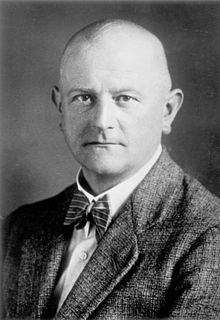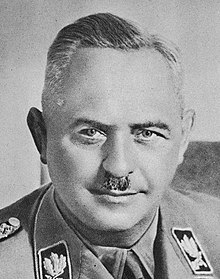Reich Ministry for Church Affairs
The Reich Ministry for Church Affairs , also Reich Church Ministry , was a ministry of the German Reich at the time of National Socialism .
Reasons for origin
Since the only Reich Bishop Ludwig Müller, who was officially in office from September 27, 1933 until his death on July 31, 1945 , the demands made by the Reich government for a standardization against considerable resistance from the regional churches and the resistance of a line still existing within the church with the name " Confessing Church " could not enforce, he was deposed as head of the church in September 1935 and the German Evangelical Church directly subordinated to a Reich Church Committee subordinate to the Reich Government and a Reich Minister for Church Affairs.
Since the plans to form a Reich Ministry for Church Affairs became known, the Confessing Church has expressed concerns about the danger of a purely state church solution and tried to prevent this with positive organizational and personal proposals.
The Reich Church Ministry was established in 1935 after it was separated from the Reich Ministry of the Interior . The Reich Ministry of Churches should especially ensure the final conformity of the German Evangelical Church.
Reichsminister Kerrl and the ministry's policy
On July 16, 1935, the previous Reich Minister without portfolio and close confidante of Hermann Göring Hanns Kerrl became Reich Minister . The District President of Hildesheim Hermann Muhs was appointed State Secretary of the Reich Ministry .
The first ordinance for the implementation of the law to safeguard the German Evangelical Church (DEK) of October 3, 1935 ordered the formation of a Reich Church Committee.
One of the first employees of the Ministry of the former belonged 1935-1940 dean of Bad Segeberg , Oberregierungsrat Ernst Szymanowski (Biberstein) , later Sturmbannfuehrer , head of the Gestapo of Opole and leaders of Einsatzkommando 6 of Einsatzgruppe C to Kiev in the Ukraine , the there until 1943 commanded the murder of 2,000 to 3,000 people, mostly Jews .
The attempt of the Nazi regime to strengthen control over church affairs signaled, albeit without intent, the beginning of a phase of regrouping for the German-Christian movement. At first, Kerrl and the efforts of his ministry were well-disposed towards the German Christians , who used the new conditions to expand their radius of action. In an attempt to bring about a ceasefire in the church struggle, the ministry established church committees led by impartials.
The forces striving for a non-denominational national church gathered in the " Church Movement German Christians ". From 1936 onwards, they tried unsuccessfully to increase the number of members and influence within the church through a relatively moderate “ Bund für Deutschen Christiane ” [ Bund for German Christianity ]. In 1937 most of these groups joined together to form the " National Church Movement German Christians ". Church minister Hanns Kerrl granted this alliance temporary support, but without increasing its ecclesiastical effectiveness.
On February 12, 1937, the Reich Church Committee resigned after the Provisional Evangelical Church Administration (VKL) had written a memorandum to Adolf Hitler on May 28, 1936 , warning against “de-Christianization” and pointing out unjust measures by the state and party.
On April 13, 1937, the “closed” Brethren were banned by the Reich Ministry, as they were assumed to have an anti-subversive (and thus anti-Nazi) attitude due to their strong emphasis on isolation from the world (which, however, did not apply to most of them). As early as May 1937, the majority of the "closed brothers" were able to reorganize themselves as the Union of Free Church Christians (BfC) with the permission of the authorities . This union, whose statutes expressly included the commitment to the National Socialist state, also joined the "open brothers" in November 1937. In 1942 the BfC merged with the Union of Baptists to form the Union of Evangelical Free Churches in Germany (BEFG).
On the other hand, the Reich Ministry tried to influence Pope Pius XII. to take over the ambassador to the Holy See Diego von Bergen . However, State Secretary Muhs was particularly critical of the ambassador and noted in August 1937 that Bergen “did not represent the National Socialist Reich with that firmness, clarity of purpose and warmth”.
On December 10, 1937, Reich Minister Kerrl instructed the head of the German Ev. Church chancellery Friedrich Werner with the management of the DEK and the Evangelical Church of the Old Prussian Union.
The ministry responded positively to the historian Hans Koch's proposal in October 1938 to open an Orthodox theological academy in the “ Third Reich ” in order to establish a connection with England to the Eastern Church , and in November 1938 informed Werner Haugg, that the seat of the institute should be in Wroclaw instead of Vienna as suggested . In 1939, the personal assistant was relieved of his duties by Minister Kerrl, Councilor von Wernsdorff.
The Reich Minister for Church Affairs subsequently issued further regulations and on August 30, 1939, ordered the following to control religious events:
- “The events of churches and ecclesiastical associations, in which a position is taken on the current situation, are undesirable in every respect. Such events in secular spaces should be avoided. In any case, any statement on domestic and foreign policy issues must be avoided in church premises. "
After the death of Minister Kerrl on December 15, 1941, State Secretary Muhs headed the ministry initially temporarily until 1942 and then as Reich Minister until the end of the Second World War .
After the end of the war, part of the files on the affairs of the Orthodox Churches in Germany , occupied territories and other countries (17 volumes, 1939–1945), on the ecclesiastical policy of the Soviet Union and the Protestant Church in Russia (5 volumes, 1935–1945), the churches in the Baltic States (3 volumes, 1928–1942), church policy in Wartheland and Upper Silesia (2 volumes, 1939–1945) taken over from the special archive at the State Military Archives in Moscow .
Web links
- Werner Haugg: The Reich Ministry for Church Affairs. Berlin 1940
- Rainer Bookhagen: The Protestant child care and the inner mission in the time of National Socialism. Retreat to the church, 1937–1945. Volume 2, 2002, ISBN 3-525-55730-2 ( digitized version )
Individual evidence
- ↑ Note on the constitution of the German Evangelical Church
- ^ Wilhelm Niemöller : The fourth confession synod of the German Evangelical Church in Bad Oeynhausen. Vandenhoeck & Ruprecht, Göttingen 1960, ISBN 3-525-55507-5 , p. 161 ( digitized version ).
- ^ Alfred Kube: Pour le mérite and swastika. Hermann Göring in the Third Reich. Oldenbourg Verlag, Munich 1987, ISBN 3-486-53122-0 , p. 60 ( digitized version )
- ↑ a b c Timeline of the Rhenish Church History ( Memento of the original of September 29, 2007 in the Internet Archive ) Info: The archive link was automatically inserted and not yet checked. Please check the original and archive link according to the instructions and then remove this notice.
- ↑ Holy sacrifices for Hitler. The Biberstein case and the Protestant Church. In: The time. No. 16/2000
- ↑ Elisabeth Müller-Luckner, Gerhard Besier: Between "national revolution" and military aggression. Oldenbourg Verlag, Munich 2001, ISBN 3-486-56543-5 , p. 70 ( digitized version )
- ↑ Wolfgang Benz, Hermann Graml a. a. (Ed.): German Christians. In: Encyclopedia of National Socialism . P. 420.
- ↑ Andreas Liese: Small religious communities between resistance and adaptation: Baptists and brothers movement. 2003, 2007 (PDF; 137 kB)
- ↑ Michael F. Feldkamp : Pius XII. and Germany. 2000, ISBN 3-525-34026-5 , pp. 76, 199 ( digitized version )
- ↑ Michail Shkarovskij: The Church Policy of the Third Reich towards the Orthodox Churches in Eastern Europe (1939-1945). Münster 2004, p. 27 ( digitized version ; source: BArch R5101 / 23173, p. 459-462)
- ^ German aristocrats in Reich and Nazi files 1871–1945
- ↑ The history of the Evangelical Church in the 3rd Reich
- ^ Fund 1470 Reich Ministry for Church Affairs
- ↑ Christian Gahlbeck, Vacys Vaivada, Joachim Tauber, Tobias Weger : Archive leaders on the history of Memel and the German-Lithuanian relations. 2006, ISBN 3-486-57902-9 , p. 320 ( digitized version )
- ↑ Frankfurter Antiquariate ( page no longer available , search in web archives ) Info: The link was automatically marked as defective. Please check the link according to the instructions and then remove this notice.

